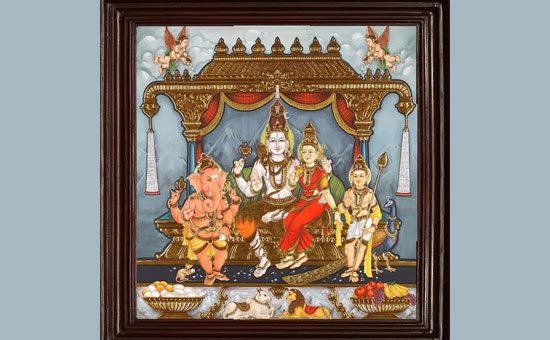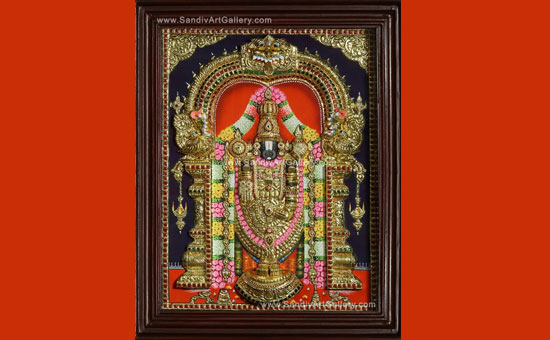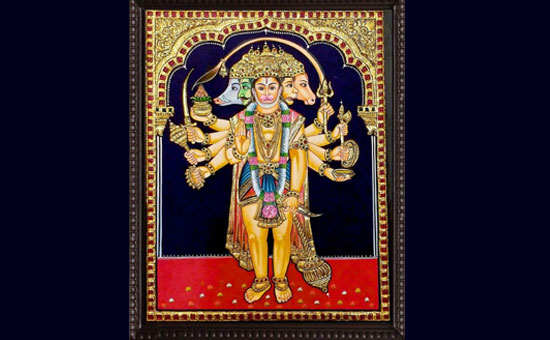-
Article covers history of Tanjore paintings, how to make a masterpiece, process of making a painting, types of frames.
Tanjore
paintings are a classical South Indian art developed in the late 16th century
in Thanjavur, also known as Tanjore in TamilNadu.
These
Tanjore paintings evoke a sense of class and timelessness with their alluring
illustrations of Puranic scenes. This ancient art form traces its origin to Tanjavur,
capital of the erstwhile CholaEmpire and is popular among contemporary Indian
women for showcasing their artistic inclination and tastes.
History of Thanjavur painting
Thanjavur
or Tanjore as it is dotingly called has a surfeit of reasons to boast of its
cultural heritage. Located at a distance of about 300 km from the capital city
of Tamil Nadu, Chennai, the city of Tanjore was the cultural capital of the Gupta
Empire and reached the zenith of its cultural development during the early
18th century. It is home to some of the world famous sanctums and temples
that have been acknowledged as the UNESCO world heritage sites. (Big Temple and
Maratha Palace).
The
vivid sculptures and murals on the walls of the temples of Tanjore uphold the
rich and ancient history of the Chola dynasty which reigned the districts of
Thanjavur, Madurai, and Trichy during the 16th century.
Of
all the gems Thanjavur boasts of, Tanjorepainting is the foremost which is
globally acclaimed for its indigenousness and unique way of creating a 3D
effect on every single artwork. The paintings of Tanjore were propagated by the
Chola kings who ruled South India during the 16th century and were
patronized by the Maratha princes.
Cholas
were great lovers of art and sculpture and that is why as you touch down at
Tamil Nadu you cannot take your eyes off the colossal temples that exemplify
their architectural style.
Development of Thanjavur painting
Thanjavur
paintings are mostly subjected to Hindu god, goddesses and saints episodes from
Hindu relics or religious texts visualized and sketched in the painting.
A
typical Tanjore painting consists of one main figure, usually a deity, with a
well-rounded face, body and oval shaped eyes. The main figure would be enclosed
using arches, curtains etc.
Tanjore
paintings are always created by a team of artisans consisting of an
experienced embosser, a visage impressionist, 22 carat gold leaf guilder and a
master artist who focuses on painting the faces with the correct expressions.Tanjore
paintings featurepuranic depictions of Goddess Lakshmi, Lord Krishna, BhagwanGanesha,
Shiva, Balaji, Veer Hanuman etc.
 Ganesha
Ganesha
Sources of Inspiration
The
inspiration for the Tanjore paintings was derived from the patronization of art
forms such as classical dance, music, literature and paintings.
Whether
on fabric or otherwise, the print has largely retained Hindu mythological
motifs that, like the paintings, are bold. The body of the fabric features one
main character at the center of the designated area while the corners are
bedecked with peripheral characters from the episode. Like a lot of other
paintings-turned-motifs, the Tanjore painting pattern is also huge in size and
is not scaled down when being printed on fabric. The beauty of the fabrics
printed with Tanjore painting motifs is their prominence on the body of the
fabric.
Overall,
there are three historical strains of influence on the Tanjore paintings viz.
Deccan, Vijayanagara, and Maratha, chronologically
Features of Thanjavur painting
Tanjore painting is popularly known as ‘palagaipadam’ which means picture on a wooden plant as most of these pictures are etched on solid wood boards. This ancient indigenous form of art is considered to be divine in its approach as most of the figurines are imitations of God and Goddesses meticulously adorned with ornaments and filled with vibrant colours.
Earlier
precious gems like diamonds and rubies were used to embellish the portraits.
Now-a-days, semi-precious Jaipur stones are used for the same purpose.
The portraits are pasted on a 22-karat gold foil and the left over space
is smeared with vibrant colours.
One
of the distinguishable features of Tanjore painting is the plumpness in the
faces of the idols which exudes the characteristic pristine look in all the Tanjore
paintings you will come across.
Although
the paintings of Tanjore are deeply entrenched in the cultural past of the
place it originated from, the painters use their skill and imagination to
create masterpieces of that art form. Tanjore painting is mostly based on Hindu
tradition. One can find numerous paintings of Lord Krishna as a baby in his varied
playful poses. The pictures also depict significant events like the marriage of
Meenakshi, Radha and Krishna, the coronation of Shri Rama and so on.
 Shiva, Parvati with their sons.
Shiva, Parvati with their sons.
The painters of this ethnic art form take great care in making the relief work of each portrait which gives them the unique 3D effect. Such paintings are used as gift items on various occasions as Diwali, Pongal, weddings and so on. They are also used as home décor for residential houses and corporate offices. The generous use of vibrant colours, brilliant gems and splashes of gold leaves a glowing impact in the darkness of a room.
 Tirupati.
Tirupati.
Making of a masterpiece
The
making of a magnum opus involves a number of steps and the most challenging of
all is creating the canvas.
At
first, the layout is drawn on the canvas base which is usually muslin cloth.
After that, chalk or zinc oxide dust is mixed with Arabic gum and a water
soluble adhesive to make a muck paste. The fixative is applied on a thin muslin
cloth and pasted on the wooden plank. Thereafter, the layout which was made at
the first step of the artwork making is gradually and meticulously decked with
various add-ons.
The
usual materials used for the beautification of a Tanjore painting are cut
glass, semi-precious gems, rich colours and laces. To augment the gorgeous
effect of the painting, 22 karat gold foils are pasted in different parts of a
figure while the rest of the areas are filled with day-glow colours that match
up with the brilliance of the painting.
Due
to use of premier quality gold foil, an authentic Tanjore painting can last for
generations without getting tarnished and a medium sized painting would be on a
little expensive side as compared to that of the others.
Creating a work of genius is never an easy task and Tanjore painters have testified this fact down the generations. Such paintings require a good deal of your passion, perseverance and perfection. Only when these three ‘P’s combine together can one produce such timeless creations. It may take between three to six months by an artist to make an authentic Tanjore painting.
To
sum up, Tanjore painting is the ultimate way of expressing devotion, truth and
skill by an artist through his/her creation.
This
ancient form of miniature artwork thrives till date through intense
craftsmanship and dedication of the artists of Tamil Nadu and is held at a high
esteem for its indigenous character.
The broad process of creating a Tanjore painting involves (The step wise making):
1.
The wooden board is first softened using glue and emery sheets.
2.
The motifs are then sketched out onto the fabric pinned onto the board and
these outlines are then finalized by sticking precious and semi-precious gems
on these lines.
3.
The spaces around the gems are then filled with a thin layer of lime or
tamarind powder mixed with gum or resin.
4.
Another thick layer of lime or tamarind powder is then used to create the
relief and inlay work.
5.
The entire painting is then cleaned and refined.
6.
Next, gold foil is placed onto the stones and the relief work.
7.
The gold foil is then snipped and tidied to give a finished look to the
painting.
 Hanumanji.
Hanumanji.
Frames
The
frames (teak wood) used for Tanjore paintings are of two types:
1.
The wooden type wherein plain type of wood is used.
2.
The Chettinad type which are more ornamental with designs.
Instead of breakable glass, "transparent acrylic sheets" are used to avoid breakage during transit.
Influence over the ages
Tanjore
paintings in their original form are a lost art that make a statement and
private agencies are constantly attempting to revive and restore them.
However, Tanjore paintings have influenced many forms of modern art such as C. Kondiah Raju’s calendar prints and Raja Ravi Varma’s western naturalism.
Present day scenario
Tanjore paintings have been adapted onto some of the richest, most artsy looking saris in the South. Making use of high-quality silk, these paintings have been ‘printed’ onto the fabric rather than painted. Since these saris are meant for formal and not festive occasions they cannot be decorated with gold foil or precious and semi-precious stones (or their substitutes). Instead, the same effects and appearance has been retained in the form of rich prints.
Innovations
In today’s day, it is impossible to use the rich materials that were originally used since that raises the cost of production immensely. Therefore, cost-effective substitutes such as plywood, synthetic colours and industrial adhesive are now being used.
Maintenance
Tanjore
paintings in and of themselves need to preserved by framing them. The silk
saris with the Tanjore painting motifs on them however, need to be
preserved like any other silk sari. It needs to be wrapped in muslin along with
naphthalene balls for protection against moths. It is preferable to dry clean
them rather than wash them.
Facts and trivia
At
its peak, Tanjore paintings made use of diamonds, sapphires, and rubies as
embellishments.
Tanjore
paintings are often confused with Mysore paintings as they share the same roots
and makers. The difference however, lies in the materials being used and their
relief work.
Two
of the major influences on this style of painting are said to be Kalamkari and Tirupati,
under the Vijayanagara School.
Author is a Mumbai based artist.
The
purpose of this compilation is to document and promote. We have given credits
and reference links in this compilation. In case some are missed, it is not
with malafide intent.
To read all
article by author